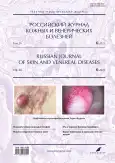Опыт применения геля бензоила пероксида и клиндамицина в лечении акне лёгкой и средней степени тяжести
- Авторы: Олисова О.Ю.1, Шепелева А.В.1, Каюмова Л.Н.1
-
Учреждения:
- Первый Московский государственный медицинский университет имени И.М. Сеченова (Сеченовский Университет)
- Выпуск: Том 26, № 6 (2023)
- Страницы: 605-622
- Раздел: ДЕРМАТОЛОГИЯ
- URL: https://journals.rcsi.science/1560-9588/article/view/254771
- DOI: https://doi.org/10.17816/dv611037
- ID: 254771
Цитировать
Аннотация
Обоснование. Акне является актуальной проблемой не только для пациентов, но и для врачей различных специальностей, особенно дерматовенерологов и косметологов. Заболеванию подвержены до 85% молодых людей. Поражение кожи на лице, отсутствие эффекта от ранее проводимой терапии часто сопровождаются выраженной психосоциальной дезадаптацией даже при нетяжёлых формах дерматоза. Кроме того, в последнее время отмечается тенденция к повышению устойчивости Cutibacterium acnes к антибактериальным средствам, что требует разработки препаратов, в том числе для предотвращения антибиотикорезистентности.
Цель исследования ― клинико-морфофункциональная оценка эффективности и переносимости средства для лечения угревой сыпи в форме геля (клиндамицин + бензоила пероксид) у пациентов с акне лёгкой и средней степени тяжести.
Материалы и методы. В исследовании участвовали пациенты с акне (n=30; 28 женщин и 2 мужчин) в возрасте от 18 до 34 лет с лёгкой (у 4) и средней (у 26) степенью тяжести заболевания. Все пациенты наносили гель (клиндамицин + бензоила пероксид) ежедневно 1 раз в день вечером. Продолжительность периода наблюдения составила 12 недель. Дерматологический осмотр проводился визуально с простым подсчётом воспалительных высыпаний (папул, пустул). С целью оценки морфофункциональных параметров кожи лица пациентам проводили основанное на 3D-визуализации неинвазивное цифровое исследование на аппарате Capricorn AI Intelligent Imager Bitmoji. Для изучения влияния заболевания на разные аспекты жизни пациента и в качестве критерия эффективности применяли дерматологический индекс качества жизни (ДИКЖ).
Результаты. У всех больных при использовании средства для лечения угревой сыпи в форме геля (клиндамицин + бензоила пероксид) отмечались регресс воспалительных и невоспалительных элементов, а также уменьшение явлений постакне, при этом улучшение состояния кожного процесса регистрировалось уже в течение первых 2–4 недель. В результате проведённого лечения в 8 случаях достигнуто полное очищение кожных покровов, в 17 ― значительное улучшение, в 5 ― улучшение. По завершении всего периода наблюдения по данным анкеты-опросника у обследуемых наблюдалось снижение ДИКЖ в сравнении с исходным (18,4±3,03 против 3,03±0,15; p <0,05), что свидетельствует об улучшении качества жизни и психоэмоционального состояния пациентов и, следовательно, эффективности терапии.
Заключение. Гель (клиндамицин + бензоила пероксид) для лечения акне лёгкой и средней степени тяжести является эффективным средством, особенно у пациентов с преобладанием пустулёзных элементов, что подтверждается результатами визуального осмотра и положительной динамикой показателей поверхностного и глубокого анализа кожи лица (себуметрия, корнеометрия, пигментация, реактивность и уровень колонизации C. acnes). Гель хорошо переносился больными, не вызывал развития нежелательных явлений и аллергических реакций.
Полный текст
Открыть статью на сайте журналаОб авторах
Ольга Юрьевна Олисова
Первый Московский государственный медицинский университет имени И.М. Сеченова (Сеченовский Университет)
Email: olisovaolga@mail.ru
ORCID iD: 0000-0003-2482-1754
SPIN-код: 2500-7989
доктор медицинских наук, профессор, чл.-корр. РАН
Россия, 119991, Москва, ул. Большая Пироговская, д. 4/1Анастасия Владимировна Шепелева
Первый Московский государственный медицинский университет имени И.М. Сеченова (Сеченовский Университет)
Автор, ответственный за переписку.
Email: dr.shepelevaavl@gmail.com
ORCID iD: 0009-0001-5251-5394
Россия, 119991, Москва, ул. Большая Пироговская, д. 4/1
Ляиля Наилевна Каюмова
Первый Московский государственный медицинский университет имени И.М. Сеченова (Сеченовский Университет)
Email: avestohka2005@inbox.ru
ORCID iD: 0000-0003-0301-737X
SPIN-код: 4391-9553
кандидат медицинских наук, доцент
Россия, 119991, Москва, ул. Большая Пироговская, д. 4/1Список литературы
- Российское общество дерматовенерологов и косметологов. Федеральные клинические рекомендации по ведению больных акне. Москва, 2020. 20 с.
- Олисова О.Ю. Современные подходы к местной терапии угревой болезни // Дерматология. Consilium Medicum. 2008. № 2. С. 15–18.
- Боровая А.С., Олисова О.Ю. Применение системного изотретиноина в лечении вульгарных угрей (обзор литературы) // Российский журнал кожных и венерических болезней. 2012. № 5. С. 47–51.
- Thielitz A., Krautheim A., Gollnick H. Update in retinoid therapy of acne // Dermatol Ther. 2006. Vol. 19, N 5. Р. 272–279. doi: 10.1111/j.1529-8019.2006.00084.x
- Jugeau S., Tenaud I., Knol A.C., et al. Induction of toll-like receptors by Propionibacterium acnes // Br J Dermatol. 2005. Vol. 153, N 6. Р. 1105–1113. doi: 10.1111/j.1365-2133.2005.06933.x
- Halvorsen J.A., Stern R.S., Dalgard F., et al. Suicidal ideation, mental health problems, and social impairment are increased in adolescents with acne: A population-based study // J Invest Dermatol. 2011. Vol. 131, N 2. Р. 363–370. doi: 10.1038/jid.2010.264
- Иллюстрированное руководство по дерматологии (для подготовки врачей к аккредитации) / под ред. О.Ю. Олисовой, Н.П. Теплюк. Москва: ГЭОТАР-Медиа, 2023. 376 с.
- Ko H.C., Song M., Seo S.H., et al. Prospective, open-label, comparative study of clindamycin 1%/benzoyl peroxide 5% gel with adapalene 0.1% gel in Asian acne patients: Efficacy and tolerability // J Eur Acad Dermatol Venereol. 2009. Vol. 23, N 3. Р. 245–250. doi: 10.1111/j.1468-3083.2008.02920.x
- Schaller M., Sebastian M., Ress C., et al. A multicentre, randomized, single-blind, parallel-group study comparing the efficacy and tolerability of benzoyl peroxide 3%/clindamycin 1% with azelaic acid 20% in the topical treatment of mild-to-moderate acne vulgaris // J Eur Acad Dermatol Venereol. 2016. Vol. 30, N 6. Р. 966–973. doi: 10.1111/jdv.13541
- McKeage K., Keating G.M. Clindamycin/benzoyl peroxide gel (BenzaClin): A review of its use in the management of acne // Am J Clin Dermatol. 2008. Vol. 9, N 3. Р. 193–204. doi: 10.2165/00128071-200809030-00010
- Cunliffe W.J., Holland K.T., Bojar R., Levy S.F. A randomized, double-blind comparison of a clindamycin phosphate/benzoyl peroxide gel formulation and a matching clindamycin gel with respect to microbiologic activity and clinical efficacy in the topical treatment of acne vulgaris // Clin Ther. 2002. Vol. 24, N 7. Р. 1117–1133. doi: 10.1016/s0149-2918(02)80023-6
Дополнительные файлы




















